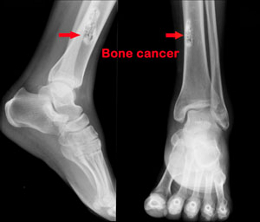Bone cancer stages are determined on the basis of the degree to which this disease has spread in the body. The TNM scoring system is used to determine the stages of bone cancer. The TNM scoring system and related facts about stages of bone cancer are explained below...

The growth of bone cells that is abnormal nature and which can be malignant and/or benign is termed as bone cancer (tumor). The malignant tumors are important from the point of study, since their growth is prolific and spreads to other parts of the body. Different types of malignant tissues which affect bones include osteosarcoma, Ewing's sarcoma, chondrosarcoma, fibrosarcoma, histiocytoma, etc. Classification for bone cancer stages is developed by the American Joint Committee on Cancer (AJCC). These stages help us understand the extent or degree to which disease has spread in the body. Let understand what are the different stages of bone cancer through this article.
What are the Stages of Bone Cancer?
The long bones of our body are most prone to the development of bone cancer, especially the arm and leg bones. Cancer which has originated in some other part of the body and spread to bones is not termed as bone cancer. The stages of bone cancer are determined with the help of two systems, i.e. the TNM and Enneking. Let us first understand the TNM system followed by Enneking in the paragraphs below.
TNM System
The TNM system is most commonly used. In the TNM scoring system, 'T' stands for tumor size, 'N' for lymph nodes affected, and 'M' for metastasis of tumor. Metastasis is the process through which tumors spread to distant organs of our body.
T Stages
In the T-stages of bone cancer, the size of the tumor goes on increasing. Let us get into the details of the T stages one by one.
- T0 Stage: In the T0 stage, no signs of tumors in bones are observed.
- T1 Stage: In T1 stage, tumor size isn't greater than 8 cm.
- T2 Stage: In the T2 stage, size of bone tumor is more than 8 cm.
N Stages
The 'N' stages are associated with the lymph nodes. The extent to which cancerous growth affects the lymph nodes is the factor which determines the N stages.
- N0: In this stage, invasion of lymph nodes by cancerous growths in not observed.
- N1: In the N1 stage, cancerous growth spreads to lymph nodes that are near the point of origin of bone cancer.
M Stages
Study of M stages of bone cancer help in understanding process of metastasis (which allows the cancer to spread to other parts of the body).
- M0: In the M0 stage, cancer has not spread to distant parts of the body.
- M1: This is the stage in which cancerous growth originated from bones spreads to the other, distant organs of body. Based on the organs being affected by this cancerous growth, the M1 stage is classified into M1a and M1b.
- M1a: In this metastasis stage, cancer spreads to the lungs. No other distant organ (apart from lungs) is affected in this stage.
- M1b: In the M1b stage, cancerous growth affects organs of the body other than lungs.
Enneking System
The grades of cancer also is an important factor in the process of classifying the stages; it is used in the Enneking system of determining the stages. Low and high grades of cancer are the two types. The lower grade cancer is less harmful than that of the higher grade. Low and high grade cancer cells are observed in first and second stage respectively. In the third and fourth stages, grade of cancer can be low and/or high. The third stage of cancer is characterized by presence of multiple tumors at the same stage. In stage 4 cancer, these multiple tumors spread out to distant organs by means of the metastasis process.
The study of bone cancer stages is generally seen from the perspective of level of progression of the particular disease. The stages in bone cancer, however, are not the indicators of the level to which this disease has progressed. The degree to which cancer has affected the body is understood by studying the topic of 'stages'. The bone cancer prognosis or outcome of this disease can be understood by determining its stage.


 The growth of bone cells that is abnormal nature and which can be malignant and/or benign is termed as bone cancer (tumor). The malignant tumors are important from the point of study, since their growth is prolific and spreads to other parts of the body. Different types of malignant tissues which affect bones include osteosarcoma, Ewing's sarcoma, chondrosarcoma, fibrosarcoma, histiocytoma, etc. Classification for bone cancer stages is developed by the American Joint Committee on Cancer (AJCC). These stages help us understand the extent or degree to which disease has spread in the body. Let understand what are the different stages of bone cancer through this article.
The growth of bone cells that is abnormal nature and which can be malignant and/or benign is termed as bone cancer (tumor). The malignant tumors are important from the point of study, since their growth is prolific and spreads to other parts of the body. Different types of malignant tissues which affect bones include osteosarcoma, Ewing's sarcoma, chondrosarcoma, fibrosarcoma, histiocytoma, etc. Classification for bone cancer stages is developed by the American Joint Committee on Cancer (AJCC). These stages help us understand the extent or degree to which disease has spread in the body. Let understand what are the different stages of bone cancer through this article.